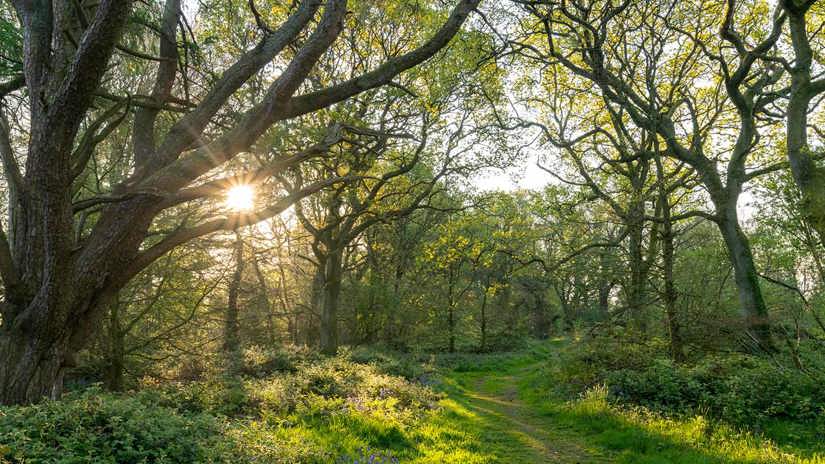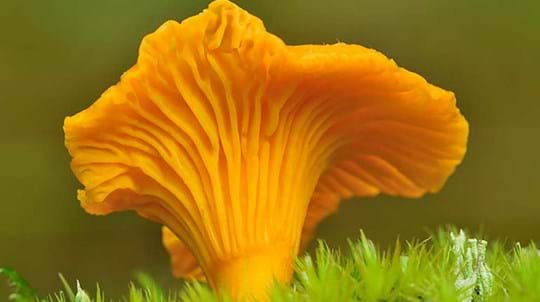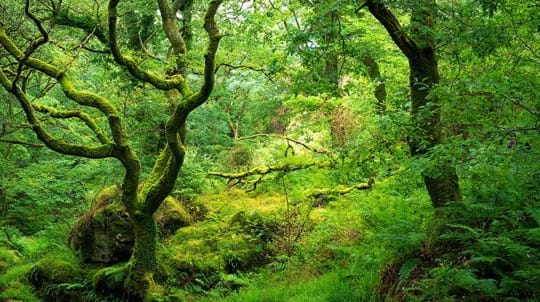
Go exploring
Primordial landscapes, tangled branches, breathtaking wildlife and miles of woodland trails. From the countryside to cities, we care for thousands of woods throughout the UK, all free to visit.
Find a wood near you
Citizen science officer
Lichens come in a range of odd shapes and varieties. But what exactly are these splodgy badges of colour? Here’s what you need to know about lichens and seven species you can spot on trees.
Lichens are actually made up of two or more different organisms. These exist in a mutually beneficial relationship called symbiosis. So you can think of lichen as a successful partnership, between:
The fungus element requires carbohydrate as a food source. The algae or cyanobacteria on the other hand require shelter. As the algae/cyanobacteria are photosynthetic they provide the food for the fungus in return for that shelter. It's a partnership that works.
You can see lichen in lots of places - with little blazes of colour cropping up on rocks, walls, twigs, bark and even on exposed soil surfaces. Different kinds of lichens have adapted to survive in some of the most extreme environments on Earth: across arctic tundra, hot dry deserts and rocky coasts.
Lichens are non-parasitic and don’t harm any plants they grow on. In fact, they’re useful to other wildlife, offering nesting material for birds, and food and shelter to lots of invertebrates - which in turn feed other creatures. Woods rich in lichens support more wildlife than any other.
Lichens can be big and bright or small and dark. What’s more, our amazing lichens can take on a variety of shapes and forms like:
Lichens are also sensitive to pollution and can highlight the quality of the surrounding air. Crusty lichens are hardier to pollution, whereas the more delicate beard-like ones are mostly found in cleaner locations and are rarer.
Ancient woodland is land that has been continually wooded for a very long time.
Because of this, ancient woods are particularly important for lichen as they provide an undisturbed environment where lichen can thrive. Lichens need this as they take a long time to develop, growing only 1-2mm a year.
Some species of lichen require alkaline conditions and are only found growing on old bark. Bark can become more alkaline with age, so species such as ash – which has a relatively high pH (alkalinity) of bark - are home to a lot of species. In fact, some 536 lichen species are associated with ash!
All of this really underlines how crucial a single ancient tree can be for our varied lichen species.
There are lots of different types and they can be difficult to identify, so here’s our guide to seven lichen species you can find in our woods and forests:
For good reasons this species is also known as 'old man’s beard'. It’s a bushy lichen which can be yellow-green or grey-green with a black base. Widespread throughout the UK, it can be found on the twigs and trunks of trees with an acidic bark, such as birch. It’s more likely to be seen on smaller branches.
Members of this genus are sometimes called strap or cartilage lichens because of those long strap-like branches. It’s a densely tufted species with swollen branched lobes. When wet it appears green, but is really grey-green. It’s common throughout the UK, often seen on twigs in sunny locations. It may be spotted on younger trees as it’s often an early coloniser.
Another strap-like species that is common throughout the UK. It’s widespread and can survive in shaded or sunny locations. It can be silvery grey-green or yellow-green with narrow flattened branches reaching up to 7cm long.
This brilliantly coloured lichen is sometimes known as common orange lichen or yellow scale. The colour can vary from yellow to orange or even grey-green if it’s in the shade. It’s found throughout the UK, especially on elder.
Also called monk’s hood lichen, this presents as a grey-green collection of swollen lobes. If the lower surface can be seen there should be a brown colouring at the margin. Like many species of lichen it’s sensitive to nitrogen pollution. It’s widespread and found on trees with acidic bark.
The pale grey, flattened branches of this lichen will hug the bark of trees tightly. The end of the each lobe is swollen and can look hood-shaped. It’s a widespread species which is more tolerant of nitrogen pollution and can be seen on the branches of various plants in nitrogen-rich soils.
This lichen is made up of bright yellow to yellow-green granules and can appear fluffy. It’s common on the bark of many trees, especially at the lower end of the trunk where dogs have urinated.

Primordial landscapes, tangled branches, breathtaking wildlife and miles of woodland trails. From the countryside to cities, we care for thousands of woods throughout the UK, all free to visit.
Find a wood near you
Trees woods and wildlife
A dazzling array of shapes, sizes and colours. Find out about fungi and lichens, from ancient taboos to magic and medicine.

Trees woods and wildlife
Home to myth and legend, where folk tales began. It fuelled our ancestors and still houses thousands of species. Ancient woodland has grown and adapted with native wildlife, yet what remains only covers 2.5% of the UK.